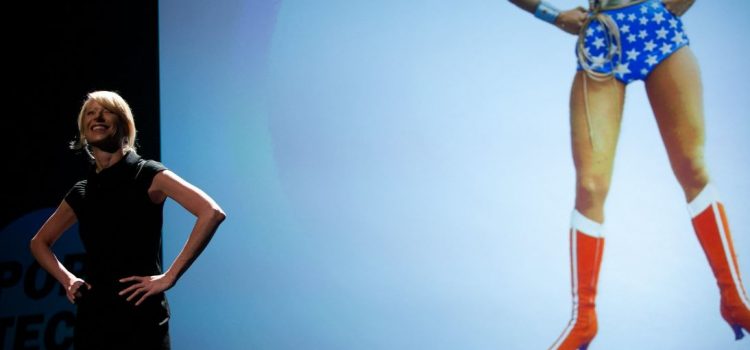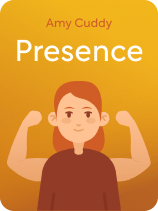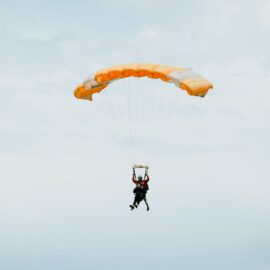

This article is an excerpt from the Shortform book guide to "Presence" by Amy Cuddy. Shortform has the world's best summaries and analyses of books you should be reading.
Like this article? Sign up for a free trial here.
Why do people recommend Amy Cuddy’s power pose as a confidence booster? How does posing like a superhero make you feel like one?
Amy Cuddy is known for her “power pose” strategy, which is a physical stance that increases the feeling of presence. Her book Presence talks about how the feeling of being “powerful” calms the mind and increases self-assurance.
Check out more on Cuddy’s power pose research and the ongoing debate over the effectiveness of the pose.
Executing the Power Pose
In Amy Cuddy’s power pose, you raise your arms up in a v-shape, place your legs shoulder-width apart, or put your hands on your hips. You can also put your own spin on power poses and create your own—the important part is that they make you expand your body outward and foster a feeling of power:
(Shortform note: Since Cuddy’s 2012 TED talk on power posing, the phrase “power pose”—coined in her 2010 research article—has integrated into popular culture. It has an entry in the Cambridge Dictionary, and some people speculated that Cuddy’s TED talk inspired politicians in the UK to strike power poses at high-profile events. Power posing also continues to be frequently listed on advice websites as a way to boost your confidence.)
The simple act of making yourself bigger—or even louder—is an expression of power recognized throughout the world and among both animals and humans. By extending your limbs, lifting your head, and raising your voice, you can bypass the negative thoughts fueling your anxiety and essentially trick your brain into feeling confident.
(Shortform note: In 12 Rules for Life, Jordan Peterson explains that it’s beneficial for animals to jockey for higher positioning on a social hierarchy through displays of dominance because it helps distribute scarce resources while avoiding combative conflict. For example, if two animals both want to hunt for food in the same area, they can make themselves look big, size each other up, and decide who’s most likely to win a fight. If one of them then backs down, they can both avoid injury or death. Peterson says that humans still have the biologically ingrained tendency to monitor signals of dominance (such as physical stature) to figure out social positioning, which may explain why power poses trigger confidence.)
Cuddy’s research on this topic found that power posing for a few minutes not only led to perceived feelings of greater confidence and agency in the subjects but also physically changed their hormone levels in a beneficial way. First, it elevated testosterone levels—the so-called “dominance hormone” that is both caused by and causes more assertive behavior. Second, it reduced cortisol levels, a hormone produced as a bodily stress response. Together, high levels of testosterone and low levels of cortisol are associated with more powerful people—they tend to be associated with successful leaders, for example.
And what if you’re physically unable to power pose? Cuddy adds that even if you can’t find a comfortable place to power pose before your big presentation or if you’re physically unable to do it, you can still benefit from power posing mentally. Research has demonstrated that simply visualizing yourself in a power pose can have the same effects as the physical exercise. (Shortform note: Although most studies have focused on physical power posing, rather than visualization of power poses, some research suggests that visualization techniques enhance performance and self-confidence for athletes—results that may be applicable to the many high-pressure contexts that Cuddy describes.)
| Controversy Over Power Posing Research Amid ongoing debates about the effects of power posing among researchers, social psychologists continue to refine the studies on this phenomenon to determine how high-power or low-power poses impact our behavior, mindset, and physiology. Here, we’ll describe how some of the controversy surrounding Cuddy’s work has unfolded. Cuddy’s research on the effects of power posing initially received widespread acclaim—she was featured on major media outlets such as CNN, Oprah, and TED. However, over the next several years, some researchers criticized the results of her original 2010 power posing study, arguing that Cuddy and her colleagues may have selectively reported data and pointing out that subsequent studies by other researchers failed to replicate the results. In 2016, the main author on the initial study, Dana Carney, stated that she no longer supported the conclusion from the study due to her updated analysis of the evidence. This evidence includes studies that found no statistically significant hormonal effect of power posing. In a 2017 interview, Cuddy stated that she’s currently undecided on whether the hormonal effects are significant, since there are wide variations in the methodologies researchers use to assess and analyze these metrics. For example, some researchers use blood samples to measure hormone levels while others use saliva samples, which can lead to discrepancies in the analyses. However, Cuddy maintains that power posing at least increases feelings of power in individuals, which can increase their performance. A 2018 study by Cuddy reviewing 55 studies on power posing, and a 2022 study reviewing 88 studies on power posing both support the finding that high-power poses significantly enhance people’s mood, attitude, and self-esteem. The effects of power posing may also be greater when comparing a high-power posture to a low-power posture as opposed to comparing the power pose to a neutral posture. In addition to the debate over her research, some of the criticism Cuddy received was targeted more at Cuddy as a person. For example, some critics railed against the amount of money she made from her book and speaking events. Some argue that this kind of backlash may have stemmed from people’s resentment toward successful, ambitious women and her popularity outside of the academic sphere. |

———End of Preview———
Like what you just read? Read the rest of the world's best book summary and analysis of Amy Cuddy's "Presence" at Shortform.
Here's what you'll find in our full Presence summary:
- How to navigate social situations, interviews, performances, and more
- The research behind power poses, and how to use them effectively
- Body language you should avoid so others won't resent you






